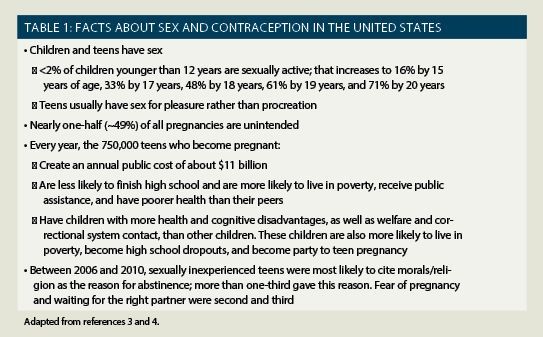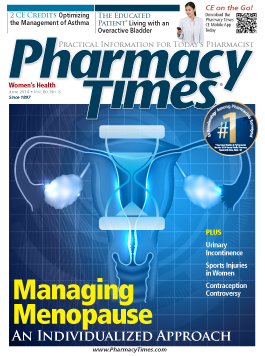Publication
Article
Pharmacy Times
Contraception Controversy: The Pharmacist's Perspective
Author(s):
In many states, pharmacists have the right to exercise conscientious refusal to dispense contraceptives, but they also have a responsibility to meet patients' and employers' needs.
In many states, pharmacists have the right to exercise conscientious refusal to dispense contraceptives, but they also have a responsibility to meet patients’ and employers’ needs.
Few of us think about the individual—and sometimes unique—drugs we’ll need to dispense when we start pharmacy school. Some of those drugs are controversial and can stir emotions. Articles about controversial issues are difficult to write and can be difficult to read. To benefit most from this article, think about your personal beliefs about coitus (sexual intercourse between men and women). What is coitus? Think about its psychological, biological, and emotional characteristics. Think about hormones and relationships, and eggs and sperm. Think about the potential for pregnancy. It’s a lot to think about.
Now, think about political and religious beliefs about sex, and what you think you know about them. Overwhelming, isn’t it? This article presents facts and offers information and a stepwise approach to developing an informed approach regarding refusal to dispense contraceptives.

Startling Realities About Sex
Sexually inexperienced Americans see plenty of sex on television. The media often imply that the most satisfying sex is an instantaneous, mutually gratifying, intimate, romantic experience. Boy meets girl, the couple falls in love, and they have completely satisfying unprotected sex soon after meeting. Any talk about birth control, sexually transmitted diseases, or erectile dysfunction isn’t included in the original script.1,2 People who have had consensual or nonconsensual sex will recognize that this is absurd. Table 13,4 presents some realities about sex.

A History of Sexual Mind-sets
For most of human history, women used birth control to conceal illicit affairs, since illegitimate birth was a source of shame, stigma, and societal and financial marginalization. By the 1950s, married couples could use a diaphragm with spermicidal jelly, condoms, or several untrustworthy methods (withdrawal, douching, or rhythm) to prevent pregnancy.5 Single women had trouble obtaining contraception or advice, since it implied unthinkable premeditation. In 1957, the FDA approved the first contraceptive pill. By 1965, 6.5 million married women and a lower number of unmarried women were on “the pill.” Medical historians have hailed it as a miracle of modern science.6
Today, among sexually active women aged 15 to 44 years, 99% have used some form of contraception.7 About 20% of women end their reproductive years childless, double the percentage in the 1970s, because contraception is available. Highly educated women are most likely never to have a child, but this is changing.8
Throughout history, religious and legal institutions have had strong influences on sex, contraception, and abortion. Religious moralities about these issues are too numerous to list. In terms of United States law, the Supreme Court decided married couples have a constitutional right to use contraception—in 1965 in Griswold v Connecticut.9 In 1972, the court reviewed this issue again and decided all adults have that same right. The 1973 Roe v Wade Supreme Court decision allowed abortion in some circumstances, if the physician judged it wise, and it empowered states to create laws about abortion.10
In the past 40 years, states have addressed abortion individually and disparately.11 In 2006, the FDA approved Plan B, the oral “morning after” pill. In June 2013, the FDA changed the status of Plan B from prescription to OTC per a federal court order.12,13 These decisions influence women’s health-related decision making and pharmacists’ practices because pharmacies sell contraception.11
Enter the Pharmacist
As contraception has changed and has become widely available, pharmacists have played a central role in its availability and distribution. Some contraception is available over the counter, some by prescription, and emergency contraception has jumped from prescription to OTC without age restrictions or limitation of sale.14,15 In the past, state and federal law has limited access to contraception based on age. At some point, emergency contraception will be available in gas stations.
Today, some states allow pharmacists to refuse to dispense contraceptives if an individual pharmacist has genuine religious or moral reasons underlying his or her refusal. Some states limit the right to refuse only to emergency contraceptives, while other states include all contraceptives. Some states allow right of conscience for individual pharmacists only if another pharmacist is available to dispense the requested medication. Ultimately, state laws have placed a minority of pharmacists in uncomfortable positions. In a very few situations, pharmacists have refused to dispense emergency contraception. Many of these situations have attracted media and watchdog group attention.16-18 Table 211,19-21 describes steps all pharmacists can take to understand the issues.
Endnote
Pharmacists’ attitudes concerning contraceptives—or any controversial medications (eg, medications that would be used under a death-with-dignity law)—can influence medication access. Eliminating personal biases and attitudes is difficult. Ultimately, tolerance and understanding are required on both sides to develop reasonable answers to the dilemma. In many states, pharmacists have the right to exercise conscientious refusal, but pharmacists also have the responsibility to meet patients’ and employers’ needs.
Ms. Wick is a visiting professor at the University of Connecticut School of Pharmacy.
References
- Pariera KL, Hether HJ, Murphy ST, de Castro Buffington S, Baezconde-Garbanati L. Portrayals of reproductive and sexual health on prime-time television. Health Commun. 2014;29:698-706.
- Parkes A, Wight D, Hunt K, Henderson M, Sargent J. Are sexual media exposure, parental restrictions on media use and co-viewing TV and DVDs with parents and friends associated with teenagers’ early sexual behaviour? J Adolesc. 2013;36:1121-1133.
- Teen pregnancy prevention. National Conference of State Legislatures website. www.ncsl.org/research/health/teen-pregnancy-prevention.aspx. Accessed May 10, 2014.
- Martinez G, Copen CE, Abma JC. Teenagers in the United States: sexual activity, contraceptive use, and childbearing, 2006-2010 national survey of family growth. Centers for Disease Control and Prevention website. http://stacks.cdc.gov/view/cdc/11653. Accessed May 10, 2014.
- Pierce CP. Santorum’s war against women [published online January 3, 2012]. Esquire website. www.esquire.com/blogs/politics/rick-santorum-contraception-6632083. Accessed May 2, 2014.
- Ten great public health achievements in the 20th century. Centers for Disease Control and Prevention website. www.cdc.gov/about/history/tengpha.htm. Accessed May 10, 2014.
- Mosher WD, Jones J. Use of contraception in the United States: 1982-2008. Centers for Disease Control and Prevention website. www.cdc.gov/nchs/data/series/sr_23/sr23_029.pdf. Accessed May 2, 2014.
- Livingston G, Cohn D. Childlessness up among all women; down among women with advanced degrees. Pew Research Center. www.pewsocialtrends.org/2010/06/25/childlessness-up-among-all-women-down-among-women-with-advanced-degrees. Accessed May 2, 2014.
- Griswold v Connecticut, 381 US 479, 485-86 (1965).
- Roe v Wade, 410 US 113, 163 (1973).
- Burstrand-Reid BA. From sex for pleasure to sex for parenthood: how the law manufactures mothers. University of Nebraska—Lincoln website. http://digitalcommons.unl.edu/lawfacpub/171. Accessed May 2, 2014.
- FDA approves over-the-counter access for Plan B for women 18 and older prescription remains required for those 17 and under. FDA website. www.fda.gov/NewsEvents/Newsroom/PressAnnouncements/2006/ucm108717.htm. Accessed May 9, 2014.
- FDA approves Plan B One-Step emergency contraceptive for use without a prescription for all women of child-bearing potential. FDA website. www.fda.gov/NewsEvents/Newsroom/PressAnnouncements/ucm358082.htm. Accessed May 9, 2014.
- Tummino v Hamburg, 2013 WL 2631163 (2013).
- FDA’s drug products with therapeutic equivalence evaluations. FDA website. www.accessdata.fda.gov/scripts/cder/ob/docs/patexclnew.cfm?Appl_No=021998&Product_No=001&table1=OB_OTC. Accessed May 10, 2014.
- Ensuring that individuals are able to obtain contraceptives at pharmacies. American Public Health Association website. www.apha.org/advocacy/policy/policysearch/default.htm?id=1335. Accessed May 9, 2014.
- Dailard C. Beyond the issue of pharmacist refusals: pharmacies that won’t sell emergency contraception. Guttmacher Institute website. www.guttmacher.org/pubs/tgr/08/3/gr080310.html. Accessed May 9, 2014.
- Pharmacy refusals 101. National Women’s Law Center website. www.nwlc.org/resource/pharmacy-refusals-101. Accessed May 12, 2014.
- Meeri K. Questions about effect of over-the-counter Plan B for all ages. Washington Post website. www.washingtonpost.com/national/health-science/questions-about-effect-of-over-the-counter-plan-b-for-all-ages/2013/06/29/82fefc78-dda1-11e2-b197-f248b21f94c4_story.html. Accessed May 2, 2014.
- Finer LB, Philbin JM. Sexual initiation, contraceptive use, and pregnancy among young adolescents. Pediatrics website. http://pediatrics.aappublications.org/content/early/2013/03/27/peds.2012-3495. Accessed May 10, 2014.
- Card RF, Williams KG. Emergency contraception, institutional conscience, and pharmacy practice. J Pharm Pract. 2014;27:174-177.







